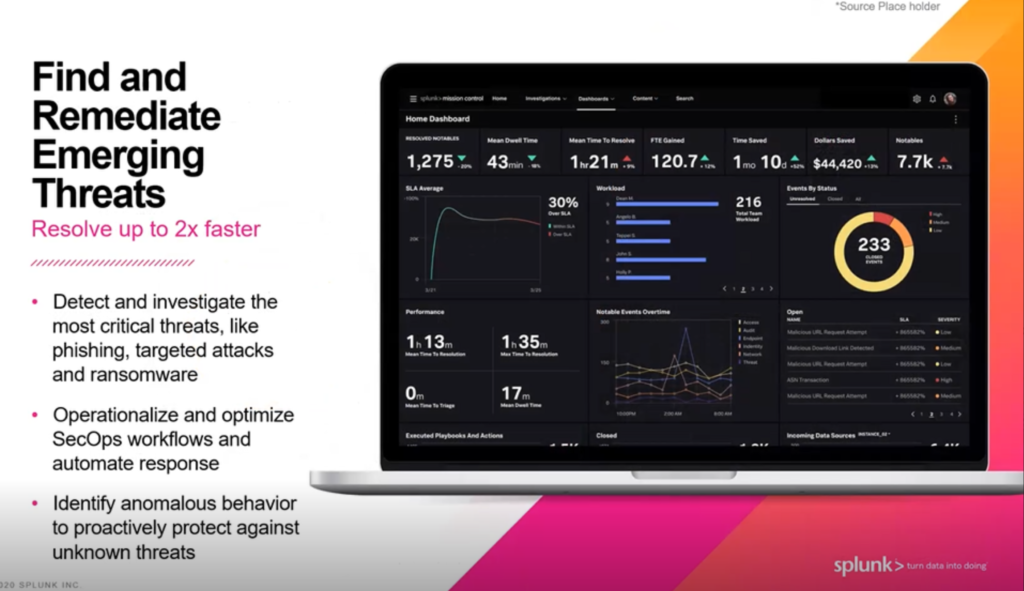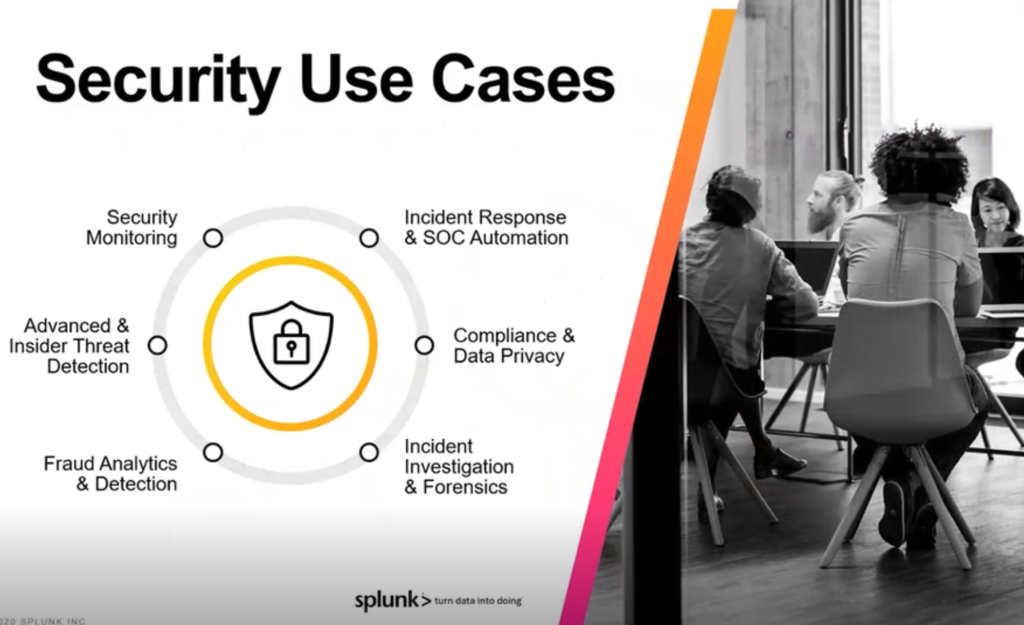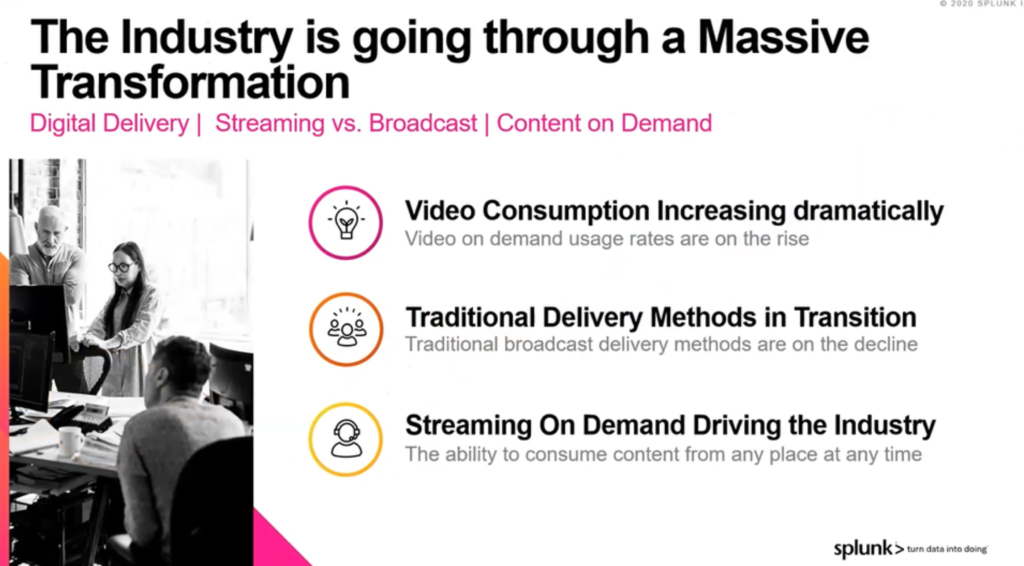M+E Daily

Splunk Helps Media Companies Secure Their Content Delivery
Story Highlights
Media organizations continue to grapple with digital transformation on a daily basis as traditional modes of content creation and delivery are being upended and new challenges including the COVID-19 pandemic come along, according to executives at Splunk.
Media companies, however, are increasingly turning to Splunk’s Data-to-Everything Platform to secure their operations, data and content, and its solution is also helping media customers cope with the additional challenges presented by the pandemic and the rapid shift to remote work, which, among other things, increased the risk for potential incidents, compromised systems, or both, Andrew Keating, director of industry marketing at Splunk, said during the Dec. 8 virtual Content Protection Summit.
“Splunk can help you make the most of your data as well as secure it in this new data age,” Beverly Smart, industry marketing manager of communications, media and technology at Splunk, pointed out during the Rights, Data & Education breakout session “Securing Next Generation Content Delivery with Splunk.”
 “At Splunk, we have an overarching mission not just to help you see the data in your organization, but most importantly, turn it into business outcomes, actionable outputs that are relevant, timely and can help you to grow your business,” she said.
“At Splunk, we have an overarching mission not just to help you see the data in your organization, but most importantly, turn it into business outcomes, actionable outputs that are relevant, timely and can help you to grow your business,” she said.
“Data is transforming everything,” she noted, explaining: “It’s transforming our personal lives as well as our workplaces. Prioritizing and automating tasks is just the beginning. Soon, data will help us reimagine our relationship with work, bringing data to complex tasks with tools like augmented reality that can provide data insights into everyday experiences.”
For media organizations, “traditional modes of content creation and presentation have been upended” by the rise of streaming services including Netflix that she noted “rely upon real-time data to understand viewer interest and shape the content they create.”
Splunk recently teamed with ESG Research to survey communications and media companies about their use of data. The study found: 60% of firms who responded to the study said they increased revenue through better utilization of their data assets; 3.4% was the average revenue increase due to better data utilization over the prior 12 months; and 93% of respondents agreed they must use data to reinvent their services or be disrupted by alternative entertainment offerings, according to Splunk.
“Content delivery is changing in the data age, and adapting to modern business environments is the name of the game for today’s media providers,” Smart said, explaining: “Companies in this sector must be able to compete in a digital world that is changing rapidly… [and] really going through a massive transformation. Delivery methods and the way content is created and consumed has changed the way media providers support their customers and partners.”
There has also been a “dramatic increase in video consumption” and “the ability for customers to consume this content from anyplace on any device is impacting infrastructure and security to keep up with the demand to prevent fraud across many different platforms,” she noted.
 COVID’s Impact
COVID’s Impact
Data analytics “can help to protect platform subscribers [and] content by identifying vulnerabilities in real-time, which is paramount in protecting intellectual properties as well as preventing security breaches,” she pointed out, adding: “At the beginning of this year, many organizations felt that they were prepared for securing their ecosystem and were ready and taking care of a lot of different things going on in their business. Then COVID hit in March and these same organizations had to pivot very rapidly to maintaining security and business processes without impacting their platforms, subscribers and content while working remotely.”
As a result, “all of us have been living through a dramatically different world in 2020 than we expected a year ago,” Keating pointed out. “COVID has upended many aspects of all of our lives and work. Certainly this has included increased challenges with multiple new endpoints and security threats if we just look at it from an IT and work standpoint.”
The pandemic impacted Splunk also, he said, telling viewers: “In March, Splunk closed our offices and shifted our company to remote work as many organizations did. Our internal IT and security teams had all sorts of new challenges that came up for them overnight and they themselves were now distributed working outside of the office, working remotely also. So our IT team got to work and security team got to work and they started designing dashboards and tools to help them support our company’s rapid shift to remote work. Pretty much immediately, we decided to make this available to customers as well. We called this solution Remote Work Insights, and it really serves to identify missing gaps in the security posture by monitoring for vulnerabilities and delivering real-time visibility across the full environment. And that includes when endpoints are individual employee laptops connecting via VPN or using remote collaboration tools.”
One of Splunk’s main objectives in 2020 has been to help its customers “cope with the challenging circumstances that everyone is facing due to the COVID-19 pandemic,” he said, explaining: “Specifically, what we’ve seen from our customers is that many organizations have realized that they need to accelerate how they leverage data across their organizations. So a lot of the trends that Beverly talked about a few minutes ago have only been accelerated and really that comes back to this use of data.”
 Some of that has been in the area of remote work, he noted. Of course, remote tools “existed before COVID in many organizations — but the shift has basically led to a dramatic increase in their usage” now, he said.
Some of that has been in the area of remote work, he noted. Of course, remote tools “existed before COVID in many organizations — but the shift has basically led to a dramatic increase in their usage” now, he said.
Splunk has worked with retailers to support initiatives including their omnichannel operations, “scaling up things like buy online and pick up in store,” he noted. The company has also worked with financial services organizations to detect things like online credit card fraud at scale as all those online transactions have grown.
And Splunk has also “worked with media organizations that have been looking to have greater visibility and insights into their streaming content,” he went on to say.
“Four Key Buckets”
When it comes to how customers are leveraging Splunk to solve today’s challenges, “we tend to see four key buckets,” he told viewers:
- Organizations are leveraging Splunk to secure and power their remote workers.
- Organizations are ensuring business continuity, including managing surges in digital demand and finding and remediating security threats faster.
- Organizations are innovating faster, improving developer efficiency and detecting and pinpointing issues.
- Organizations are confidently adopting public cloud, including optimizing and controlling costs, and strengthening cloud security. “We’re helping customers migrate more workloads to the cloud while controlling their costs and maintaining a unified cloud security posture.”
Specific ways in which Splunk is helping media service providers are: Providing them with greater visibility to drive increased audience engagement; enhancing revenue growth by gaining better insights to subscriber attachment rates; and stopping fraud, protecting investments in content, services and platforms in real time, Keating said.
“With Splunk, you can address all your security challenges to redefine your” Security Operations Center (SOC) and “to better detect, respond and, most importantly, adapt at machine speed,” he noted, adding: “You can make Splunk the nerve center to which you can optimize people, process and technology to drive smarter decisions and actions like never before. An analytics-driven approach to security can be used to provide specific guidance and address a variety of use case areas.”
 Security threats are getting “more sophisticated and the attack surfaces are expanding every year – and that was before the pandemic,” he pointed out, explaining: “Now, security teams face an expanded attack surface created by this move to remote work and new COVID-related attacks that capitalize on the uncertainty that a crisis creates. Security teams that use Splunk are able to find and remediate these security threats up to two times faster. Our customers are able to use Splunk advanced analytics to find the needles in the haystack and prioritize their threat response appropriately. And with Splunk security orchestration, automation and response capabilities, security teams can automate their SecOps workflows to stop threats at machine speed.”
Security threats are getting “more sophisticated and the attack surfaces are expanding every year – and that was before the pandemic,” he pointed out, explaining: “Now, security teams face an expanded attack surface created by this move to remote work and new COVID-related attacks that capitalize on the uncertainty that a crisis creates. Security teams that use Splunk are able to find and remediate these security threats up to two times faster. Our customers are able to use Splunk advanced analytics to find the needles in the haystack and prioritize their threat response appropriately. And with Splunk security orchestration, automation and response capabilities, security teams can automate their SecOps workflows to stop threats at machine speed.”
Presented by Microsoft Azure, the Content Protection Summit was sponsored by SHIFT, Genpact, Akamai, Convergent Risks, Friend MTS, GeoGuard, PacketFabric, Palo Alto Networks, Richey May Technology Solutions, Splunk, Zixi, EIDR, Cyberhaven and Xcapism Learning.
The event was produced by MESA, CDSA, the Hollywood IT Society (HITS) and Women in Technology Hollywood (WiTH), under the direction of the CDSA Board of Directors and content advisors representing Amazon Studios, Adobe, Paramount, BBC Studios, NBCUniversal, Lionsgate, WarnerMedia, Amblin Entertainment, Legendary Pictures, and Lego Group.









